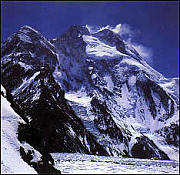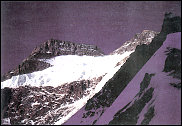
Home
Today's News
8000 Meters Facts
Banners Ads
Bookstore
Classified Ads
Climb
for Peace
Contact
E-mail
(Free)
Educational
Expeditions
Facts
Forum
Games
Gear
History
Interviews
Mailing
List
News
(current)
News Archives
Sat Phones
Search
Seven Summits
Snowboard
Speakers
Students
Readers
Guide
Risks
Visitor
Agreement
| |
|
| ||||||
|
Broad
Peak:
Some background and History | ||||||
Longitude: 76° 34' 25'' E. Latitude: 35° 48' 35'' N. He is stated to have failed in persuading porters to carry loads beyond Concordia above the Baltoro glacier. Accordingly, the party carried the luggage and made an attempt, from the south-western side, through the lower Broad glacier. It however, did not meet with success because of a storm and a very low temperature. In 1957, an Austrian expedition came to Pakistan to climb this peak. It was led by Marcus Schmuck. Other important members of the party were Fritz Wintersteller, Kurt Diemberger, climber and photographer and a legendary mountaineer, and Hermann Buhl, who is considered one of the best known postwar Austrian climbers and the first climber to Summit Nanga Parbat. The group began a reconnaissance of a ridge on the western face of the mountain. Consequently they climbed a snow gully and camped at 5791 meters. While climbing, they made the best use of ropes which were fixed by the 1954 German expedition. On the May 29th, all members of the expedition left Camp 3 for an assault on the summit. A storm forced them to return to the base camp. It was, however, on June 9th, 1957 that Marcus Schmuck, Fritz Wintersteller, Kurt Diemberger and Hermann Buhl climbed the peak without using oxygen and high altitude porters.
1219 meters on the south west face of the summit, first on hard snow and then in deep powder. They were back at base camp just 52 hours after their departure. What an extraordinary feat of self-discipline, endurance and sheer determination. The un-named peak so climbed is probably the Skill Brum peak of Jerziwala Polish maps. The other two climbers, Diemberger and Buhl, headed towards Chogolisa peak where Buhl met his death by falling from the mountain. The name of other peak in the Broad range is Broad Peak middle/central Some maps show its height at 8016 meters while the others show it 8000 meters. It is stated to have been climbed in 1975. Anyhow, it was in 1976 that a French expedition led by Yan nick Seigneur made an attempt on this peak in alpine style, along with main Broad peak. This party of four followed the Austrian first ascent route and made four attempts but could go only up to 7925 meters. The expedition had to come back because of bad weather. A six member Spanish mountaineering expedition climbed Broad (central) peak in 1987. The leader of the party was Josef Estruch. The third peak in the Broad range is Broad peak North. Again some maps show its height as 7538 meters while the others show it 7550 meters. An Italian expedition, which was led by Renato Casarotto, attempted to climb it in 1982 but was unsuccessful. The party shows its height as 7600 meters. Casarotto, however, succeeded in climbing it in 1983. Name: "Broad Peak" was bestowed by W.M. Conway. The literal translation into Balti, Phalchan Kangri has no acceptance among the Baltis. The sheer bulk of the mountain, so aptly named by Conway, is what seems to have impressed most travelers. It dominates the left bank of the Godwin-Austen glacier for most of the latter's length. Its three summits are linked by a long, tortuous crest, steep and heavily corniced. 1957 FIRST ASCENT Austrian expedition, four members, leader M. Schmuck, left Skardu April 18. Their porters left rather hurriedly and the climbers were obliged to ferry the loads for the last few kilometers to Base Camp, positioned on the true left side of the Godwin-Austen glacier a little beyond Pt. 6230 at 4910 m. The line of ascent was to be directly up the avalanche free West Ridge leading to the snow Plateau, thence up a hanging glacier to the small col and along the crest to the actual summit. They set off May 13; three camps were placed along the West Ridge, the third on May 28 at 6950 m after they had been back in Base Camp for a few days rest. Early next morning, May 29, the four climbers (H. Buhl, K. Diemberger, Schmuck and F. Wintersteller) left for the summit; they reached the col at 3 p.m. and continued on along the ridge until they thought they had at last reached the top. But it was not so for there was another summit, only some 15 m. to 20 meters higher than theirs, rising beyond a shallow dip and about one hour away; it was too late to go any further so they turned back. After a few more days rest in Base Camp the team set off again, June 7; they reached camp II (6350 m) in one day and were able to leave Camp IV very early on June 9. Schmuck and Wintersteller were the first pair to reach the summit (all without oxygen); Buhl, troubled by fierce pains in his right foot (he had lost two toes as a result of frostbite on Nanga Parbat), finally gave up when still below the subsidiary summit; Diemberger continued alone and reached the top at about 6 p.m. just as the first pair were leaving. On his return Diemberger met Buhl who, refusing to be beaten, had struggled up to the subsidiary summit. Without stopping, Buhl went on, plodding slowly for the goal. Diemberger paused, turned round and followed after Buhl. They reached the summit together. It was half past midnight when they got back to Camp III. (Diemberger followed by Buhl, June 27, after turning back when within striking distance of the summit of Chogolisa (7654 m), were groping their way back along the precipitous and heavily corniced S.E. Ridge when suddenly one of the cornices broke off and Buhl plunged to his death). 1974 Japanese expedition, eight members, leader T. Arioka had intended to climb K12 but unexpectedly the Pakistan Government gave them a permit for the more difficult Broad Peak shortly before they were due to leave Japan. They did not have time to plan an assault on this peak but decided to attempt its North summit instead. Base Camp was established at Concordia June 30, and Camp I on the Godwin-Austen glacier at 4875 m. They were unable to find a way up the West Ridge so turned their attention to the north. They are reported as having tried to reach the summit along the N.E. Ridge from Sella La (6159 m) but found it too long and had to turn back after reaching 6300 m. Reports mention the attempt as being on "The 8000m North Peak". It is the Central Summit which is 8000 m and it seems that it must have been this summit that Arioka was aiming for and not the North Summit (7538 m): this would make an approach from the Sella La more understandable. 1975: CENTRAL SUMMIT - FIRST ASCENT Polish expedition, 14 members, leader J. Ferenski, landed at Skardu June 13 and reached Concordia June 29 with the intention of climbing Central Summit. Base Camp was placed on the middle moraine of the Godwin-Austen glacier at 4950 m. The line of ascent was much the same as for the 1957 Austrian climb and again three camps were set up, the last at 7200 m, July 13. A summit team of six - R. Bebak, K. Glazek, M. Kesicki, J. Kulis, B. Nowaczyk and A. Sikorski - left Camp III early the morning of July 28, and reached the small col after 12 ˝ hours climbing; Bebak was obliged to turn back just short of the col. The other five reached the summit at 7.30 p.m. - 16 ˝ hours from Camp III. The height quoted by the Poles is 8016 m. On the way back to the col, in a raging snow storm, Nowaczyk disappeared down the east side of the ridge. The others were obliged to bivouac on the col and next morning the search for Nowaczyk continued but to no avail. A second bivouac lower down became necessary but just before this Kesicki, Kulis and Sikorski slipped and fell; Kesicki and Sikorski were both killed. The two survivors reached Base Camp, with the help of their collegues, August 1. 1976 A small French expedition of four (B.Mellet, J-C.Mosca and Y.Seigneur with Dr. D.Mennesson in support) set off with the intention of climbing the Central and Main summits in alpine-style, without the help of porters beyond Base Camp. The line followed was that of the Austrian 1957 ascent. They were dogged by exceptionally bad weather and despite four attempts - the last one to beyond the small col on the way to the Main summit - they were forced to give up in the face of terrific winds and intense cold. High point reached was about 7850 m, June 30. 1977 Second Ascent: A Japanese expedition of 13 members, leader M.Yasua, arrived on the Godwin-Austen glacier with the intention of climbing the mountain by the Austrian 1957 route. Base Camp was established at about 4900 m on July 7. Four further camps were set up along the route, the last at 7500 m, August 2. From there three climbers - K. Noro, T. Ozaki and Y. Tsuji - reached the summit on August 8. 1978 Third Ascent: A French expedition of four members left Skardu on May 15 and established Base Camp on the Godwin-Austen glacier at 4800 m, May 27. Two days later G. Bettembourg, Y. Seigneur and cameraman G. Sourice set off to climb Broad Peak by the Austrian 1957 route and bivouacked at 6100 m but the weather turned foul and they had to withdraw to Base. On June 2 they set off once more for their bivouac site and the day after they continued up to 7500 m where they bivouacked again. On June 4 Bettembourg and Seigneur reached the summit and came down again to their high bivouac. The following day they went down to Base Camp. For Broad Peak Expeditions and News see here.
| ||||||

 Send email to webmaster@everestnews.com • Copyright© 1998-2003 EverestNews.com
Send email to webmaster@everestnews.com • Copyright© 1998-2003 EverestNews.comAll rights Reserved. This material may not be published, broadcast, rewritten, or redistributed.
Disclaimer, Privacy Policy, Visitor Agreement, Legal Notes: Read it.




